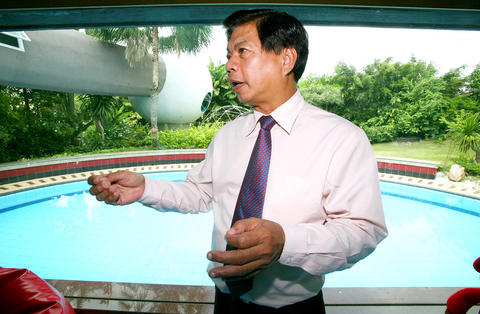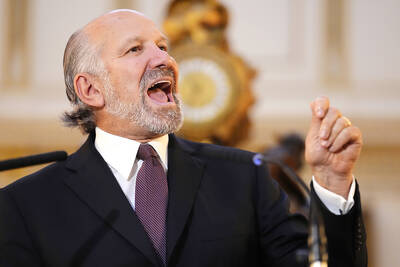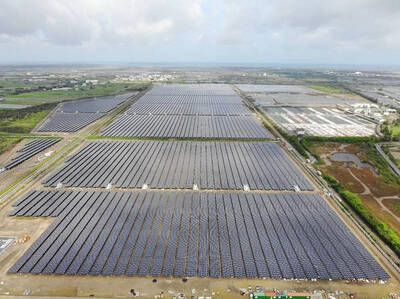Soontorn Boonyatikarn is a man of the times, throwing around terms like "eco-design" as he enthuses about the charcoal water recycling system at the Bangkok home he designed for his family two years ago.
His Bio-Solar House - designed not only to be energy efficient but to produce energy - was inspired by the humble mango tree, echoing the ideas of some of the brightest international names working in eco-architecture today.
"I threw the mango seed into the backyard. Three years later I picked up a mango," Soontorn said. "The mango tree does not need anything. The mango tree recycles everything, and it survives by the wind and the sun."

PHOTO: AFP
Unfortunately for this middle-aged professor of architecture, he is ahead of his time in Thailand, where despite abundant sunshine and a construction boom, talk of solar power and energy-efficient building design is largely rhetoric rather then reality.
But a few "green" projects are taking root.
When Soontorn built his first "eco-home" 15 years ago, everyone thought he was mad, he says. But in the past 10 years, he has designed about 200 homes, as well as a university and a handful of commercial properties.
"Now the impact is not strong, but it is getting there. With global warming, it is a sign that people have to think about the systems (they use)," he says.
Electricity for the Bio-Solar House is generated by 62.5m2 of solar paneling. They provide a surplus of energy, and every month Soontorn sells up to 1,000 baht (US$29) of electricity back to the national power grid.
All water is recycled, with the highly-insulated house also collecting dew, rain and condensation from the air conditioning.
Heat from the air conditioning warms the pool and the hot water, while the house is designed to make the most of natural light and air flow - simple measures that experts say would improve life for millions of people.
A recent report by the UN's Intergovernmental Panel on Climate Change said that eco-friendly buildings cut greenhouse gas emissions and reduce death and illness caused by poor air quality, especially in the developing world.
Some property developers are catching on to the fact that it is not just the environment that benefits but their bank balances too.
Bruno Pingel is president of Siam Best Enterprise, the firm behind Ocean 1 Tower, an eco-friendly apartment block the firms says will be the tallest building in Thailand.
He estimates that making Ocean 1 energy efficient costs just one percent of the total outlay, and says the money is quickly made back in energy savings.
The 91-floor luxury block, due to be completed by 2011 in the resort town of Pattaya, will use solar panels to power its shopping center, while the momentum of the lifts will also produce electricity.
Like Soontorn's house, the air conditioning will heat the water, and 80 percent of the water from the showers and taps will be cleaned and used to flush the toilets and fill the fountains and swimming pool.
"You have the hot water for free. You can charge the customers who live there and let them pay for the electricity they would have used for this amount of hot water, and you give them a 50 percent discount," Pingel says.
"So they are happy and you get your money back in about one or two years for the solar hot water system."
And as terms like "eco-chic" start appearing in the style sections of the world's newspapers, there is undoubtedly a certain cache in going green.
"For me, it's a selling aspect," says Pingel. "More and more people are into this issue (of global warming)."
But despite growing awareness and excited talk of an eco-building boom in Asia, Shailendra Yashwant, a climate campaigner with environmental group Greenpeace, says Thailand still has a long way to go.
"The policy makers will tell you that the potential is immense, but none of them are working on removal of barriers," he says.
"It is imperative that governments and financial institutions enforce legislation and mandatory requirements for all new buildings to incorporate and adopt 'green building' concepts," he adds.
Bangkok's Governor Apirak Kosayodhin in May announced an environmental plan for the capital, which included promoting energy-efficient buildings. But as yet, no incentives or laws for green buildings have been put forward.
Nikom Wairachpanit, director of the Bangkok Metropolitan Administration's environment department, says they will switch to energy-saving light bulbs and simply ask other government and commercial buildings to do the same.
"We don't plan for any measures to enforce them. If we do not receive any cooperation, we may consider later what should we do," he said.
"We are confident people are aware of global warming and ... will comply."
Yashwant predicts that brightly lit and inefficient buildings will dominate Bangkok's skyline for years to come, and it be some time before "eco-houses" start sprouting up like the mango trees they aim to copy.
"Soontorn's house is an experiment at best, that will be replicated by a few wealthy or alternative minded individuals," he says.

In recent weeks the Trump Administration has been demanding that Taiwan transfer half of its chip manufacturing to the US. In an interview with NewsNation, US Secretary of Commerce Howard Lutnick said that the US would need 50 percent of domestic chip production to protect Taiwan. He stated, discussing Taiwan’s chip production: “My argument to them was, well, if you have 95 percent, how am I gonna get it to protect you? You’re going to put it on a plane? You’re going to put it on a boat?” The stench of the Trump Administration’s mafia-style notions of “protection” was strong

Every now and then, it’s nice to just point somewhere on a map and head out with no plan. In Taiwan, where convenience reigns, food options are plentiful and people are generally friendly and helpful, this type of trip is that much easier to pull off. One day last November, a spur-of-the-moment day hike in the hills of Chiayi County turned into a surprisingly memorable experience that impressed on me once again how fortunate we all are to call this island home. The scenery I walked through that day — a mix of forest and farms reaching up into the clouds

With one week left until election day, the drama is high in the race for the Chinese Nationalist Party (KMT) chair. The race is still potentially wide open between the three frontrunners. The most accurate poll is done by Apollo Survey & Research Co (艾普羅民調公司), which was conducted a week and a half ago with two-thirds of the respondents party members, who are the only ones eligible to vote. For details on the candidates, check the Oct. 4 edition of this column, “A look at the KMT chair candidates” on page 12. The popular frontrunner was 56-year-old Cheng Li-wun (鄭麗文)

“How China Threatens to Force Taiwan Into a Total Blackout” screamed a Wall Street Journal (WSJ) headline last week, yet another of the endless clickbait examples of the energy threat via blockade that doesn’t exist. Since the headline is recycled, I will recycle the rebuttal: once industrial power demand collapses (there’s a blockade so trade is gone, remember?) “a handful of shops and factories could run for months on coal and renewables, as Ko Yun-ling (柯昀伶) and Chao Chia-wei (趙家緯) pointed out in a piece at Taiwan Insight earlier this year.” Sadly, the existence of these facts will not stop the